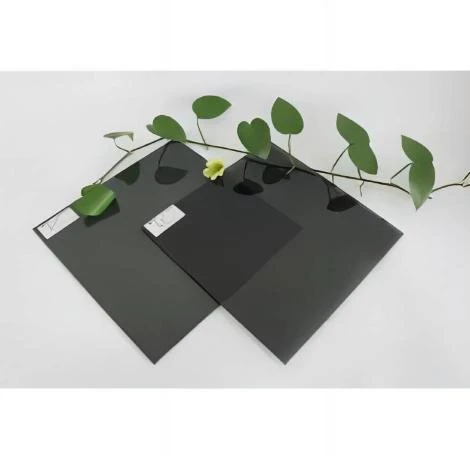The Journey of Toughened Glass Understanding the Manufacturing Process
Toughened glass, also known as tempered glass, is a remarkable material that has transformed various industries, especially in architecture, automotive, and safety applications. The creation of this durable product involves intricate processes that not only enhance its strength but also ensure its safety and aesthetic appeal. In this article, we will explore the manufacturing process of toughened glass and why it has become a preferred choice across various sectors.
Understanding Toughened Glass
Toughened glass is produced through a thermal treatment process that involves heating the glass to a high temperature and then rapidly cooling it. This process increases the glass's strength by inducing compressive stresses on its surface, making it about five to seven times stronger than standard glass. Moreover, if broken, toughened glass shatters into small, blunt pieces rather than sharp shards, which drastically reduces the risk of injury. These properties make it an ideal material for high-traffic areas, facades, and places requiring enhanced security.
The Manufacturing Process
The journey of toughened glass begins with the selection of raw materials. High-quality silica sand, soda ash, and limestone are the primary components used to manufacture glass. The raw materials are mixed and melted in a furnace at temperatures exceeding 1,600 degrees Celsius. During this phase, impurities are eliminated, and the materials are transformed into a molten glass.
Once the glass has reached a uniform consistency, it is formed into sheets of desired dimensions. This can be achieved through several methods, including the float process, where molten glass is floated on molten tin to create flat sheets, or by rolling and pressing techniques. After forming, the glass sheets are gradually cooled and then cut to size, ready for the toughening process.
The Toughening Process
toughened glass factory
The actual toughening process begins once the sheets are prepared. Each sheet is heated in a specially designed furnace to temperatures between 600 and 700 degrees Celsius. This heating phase lasts for a few minutes and is critical, as it prepares the glass for the subsequent rapid cooling stage.
After reaching the required temperature, the glass sheets are subjected to sudden cooling, known as quenching. This is typically done using jets of cool air, which create a temperature differential between the surface and the core of the glass. As the outer layer cools rapidly, it contracts and forms a compressive layer, while the inner core remains at a higher temperature and expands. The result is a state of internal stress that significantly enhances the glass's strength.
Quality Control and Testing
Quality control plays a crucial role in the production of toughened glass. Each batch undergoes rigorous testing to ensure it meets safety and durability standards. Various tests, including impact resistance, thermal shock resistance, and visual inspections for clarity and distortion, are performed. Only glass that passes these tests can be deemed suitable for commercial use.
Applications and Benefits
Toughened glass is widely used in a variety of applications, from shower doors and glass tables to skyscraper facades and vehicle windows. Its strength and safety features make it an ideal choice for both residential and commercial properties, while its aesthetic qualities offer an elegant appeal that enhances modern architecture.
Conclusion
The toughened glass manufacturing process is a blend of art and science, resulting in a product that is both practical and visually appealing. As technology continues to advance, we can expect even more innovative applications and enhancements in toughened glass production, further cementing its status as a vital material in contemporary construction and design. By understanding the intricacies of its manufacturing process, we gain a deeper appreciation for this remarkable glass and the impact it has on our daily lives.
 Afrikaans
Afrikaans  Albanian
Albanian  Amharic
Amharic  Arabic
Arabic  Armenian
Armenian  Azerbaijani
Azerbaijani  Basque
Basque  Belarusian
Belarusian  Bengali
Bengali  Bosnian
Bosnian  Bulgarian
Bulgarian  Catalan
Catalan  Cebuano
Cebuano  Corsican
Corsican  Croatian
Croatian  Czech
Czech  Danish
Danish  Dutch
Dutch  English
English  Esperanto
Esperanto  Estonian
Estonian  Finnish
Finnish  French
French  Frisian
Frisian  Galician
Galician  Georgian
Georgian  German
German  Greek
Greek  Gujarati
Gujarati  Haitian Creole
Haitian Creole  hausa
hausa  hawaiian
hawaiian  Hebrew
Hebrew  Hindi
Hindi  Miao
Miao  Hungarian
Hungarian  Icelandic
Icelandic  igbo
igbo  Indonesian
Indonesian  irish
irish  Italian
Italian  Japanese
Japanese  Javanese
Javanese  Kannada
Kannada  kazakh
kazakh  Khmer
Khmer  Rwandese
Rwandese  Korean
Korean  Kurdish
Kurdish  Kyrgyz
Kyrgyz  Lao
Lao  Latin
Latin  Latvian
Latvian  Lithuanian
Lithuanian  Luxembourgish
Luxembourgish  Macedonian
Macedonian  Malgashi
Malgashi  Malay
Malay  Malayalam
Malayalam  Maltese
Maltese  Maori
Maori  Marathi
Marathi  Mongolian
Mongolian  Myanmar
Myanmar  Nepali
Nepali  Norwegian
Norwegian  Norwegian
Norwegian  Occitan
Occitan  Pashto
Pashto  Persian
Persian  Polish
Polish  Portuguese
Portuguese  Punjabi
Punjabi  Romanian
Romanian  Russian
Russian  Samoan
Samoan  Scottish Gaelic
Scottish Gaelic  Serbian
Serbian  Sesotho
Sesotho  Shona
Shona  Sindhi
Sindhi  Sinhala
Sinhala  Slovak
Slovak  Slovenian
Slovenian  Somali
Somali  Spanish
Spanish  Sundanese
Sundanese  Swahili
Swahili  Swedish
Swedish  Tagalog
Tagalog  Tajik
Tajik  Tamil
Tamil  Tatar
Tatar  Telugu
Telugu  Thai
Thai  Turkish
Turkish  Turkmen
Turkmen  Ukrainian
Ukrainian  Urdu
Urdu  Uighur
Uighur  Uzbek
Uzbek  Vietnamese
Vietnamese  Welsh
Welsh  Bantu
Bantu  Yiddish
Yiddish  Yoruba
Yoruba  Zulu
Zulu 

